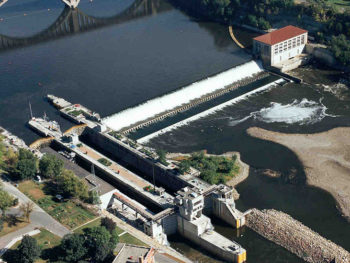Mississippi Gorge Restoration Depends on Corps Study
The Army Corps of Engineers is conducting a study to determine if dams in the Mississippi Gorge still provide use. Jo-Ellen Darcy, former Assistant Secretary of the Army (Civil Works), highlights the importance of the disposition study and how you can help.
This guest blog from Jo-Ellen Darcy, former Assistant Secretary of the Army (Civil Works) and American Rivers board member, is a part of our America’s Most Endangered Rivers® series on the Mississippi River Gorge.
American Rivers named the Mississippi River Gorge in Minnesota one of America’s Most Endangered Rivers® of 2018 because of the threat posed by outdated locks and dams. This is a critical year, as the U.S. Army Corps of Engineers (Corps) is conducting a “disposition” study of locks and dams in the river. On a political landscape rife with conflict, these little-known studies are proving to be rare points of consensus between conservatives and environmentalists. What are they and why is the Corps conducting them across the nation?
What is a disposition study?
Disposition studies, authorized by Section 216 of the Flood Control Act of 1970, evaluate infrastructure owned by the United States and managed by the Corps. This study will answer one simple question— is the infrastructure still fulfilling its purpose? To find the answer to this question, the Corps focuses on a few things:
- Why was the infrastructure constructed? Congress authorizes each piece of federal infrastructure for a specific purpose or purposes, such as navigation, flood control and/or ecosystem restoration. The Corps looks back at that purpose(s) and evaluates the current need for the infrastructure.
- How much does the infrastructure cost to operate and maintain compared to the benefits it provides? The federal income tax pays for most federal infrastructure costs. So, the Corps evaluates the national impacts of the benefits and costs.
The answers to these questions will determine the value of the infrastructure to the nation. If the Corps finds the infrastructure is no longer valuable, then it will make a recommendation to dispose of the infrastructure. In most instances, Congress must act before the disposal can move forward.
What does infrastructure disposal look like?
Disposal does not necessarily lead to removal of the infrastructure. For example, a completed disposition study of five dams on the Green and Barren River in Kentucky recommended disposing of all five dams. Two of the dams will be transferred to local municipalities for water management, the U.S. Fish and Wildlife Service has removed one dam in Mammoth Cave National Park, and removal of the remaining two dams will likely be completed through partnerships with local conservation organizations.
The disposal and dam removal projects on the Green and Barren Rivers are not complete. But their success is the result of a partnership forged between environmentalists and conservative state leaders. In an era of divisive politics, infrastructure disposal is a rare point of consensus between environmentalists and conservatives.
Conservatives support infrastructure disposal because it helps reduce federal spending on projects that might not be valuable to the nation anymore. Environmentalists support disposal because it provides an opportunity to remove environmentally damaging infrastructure, like dams. Truly a bi-partisan endeavor.
What is the status of the disposition study in the Mississippi River Gorge?
On the Mississippi River in Minneapolis-St. Paul, the disposition study is now underway for Upper St. Anthony Falls Lock, Lower St. Anthony Falls Lock and Dam, and Lock and Dam 1. The Corps will examine the purpose, costs and benefits of the three locks and two dams in the Gorge. In mid-July, the Corps will host public meetings to gather input on the scope of the study. They will give an overview of the study process and listen to the community.
The Corps will release a draft report for public review in spring 2019. The report will recommend one of two options:
- Keep the locks and dams in Federal ownership. In this case, the Corps would continue to operate and maintain them. Under this option, additional studies will still be possible to consider alternate uses.
OR
- Dispose of the locks and dams by releasing them to another entity. If disposal is recommended, Congress must act to deauthorize them and provide direction on how they should be released.
As the Corps works to determine the future of the three locks and dams on the Mississippi, it is essential that they hear from the people in the community. There are several opportunities for public input. The best decisions are made when people are engaged in the process.
If you are in the area, attend a public meeting:
July 16th at 6PM at Mill City Commons, 704 Second St. S., Minneapolis, MN 55401
July 17th at 6PM at Highland Park Senior High School auditorium, 1015 Snelling Ave S, Saint Paul, MN 55116
[su_button url=”https://act.americanrivers.org/page/4987/action/1″ background=”#ef8c2d” size=”4″ center=”yes”]Take Action »[/su_button]
 Author: Jo-Ellen Darcy
Author: Jo-Ellen Darcy
Jo-Ellen Darcy is a former Assistant Secretary of the Army (Civil Works) and American Rivers board member.






2 responses to “Mississippi Gorge Restoration Depends on Corps Study”
Kelly’s comment did not even mention what those four Snake River Dams did to the salmon runs. I am no expert on this topic, but I do know a judge has expressed concern about the value of these dams.
I think this is what progress is all about. Knowing when something has past it’s life cycle and needs to be removed for other stuff (be in infrastructure or natural growth) to improve the area. This is also the case for the 4 Lower Snake River Dams in Washington State.
The Snake River is an offshoot of the Columbia River and these 4 dams have never reached the Navigation numbers that were predicted. What’s more, the farmers who used to use the barges to traffic goods have moved to the railway which parallels the Snake River. This railway has increased in the last years and made the barge near obsolete.
The dams are also not producing necessary power. They’re generating surplus power – power that is excess and thus, unnecessary for paying customers. Washington has a gross amount of surplus power and would be better off without these 4 dams. However, because these dams are not flood control and cannot store water for long periods, the turbines cannot be turned off and thus must always be running (at least some of them). Thus, power is always being generated. It’s a viscous cycle that needs to stop.
Do you, Mrs. Darcy, know of whom we can speak with within the Corps to have them take a serious look at the 4 Lower Snake River Dams. I have reports ready that outline the statements I’ve made and can show the 4 dams need to be breached immediately. Please let me know you I can send them too.
Kind regards,
Kelly